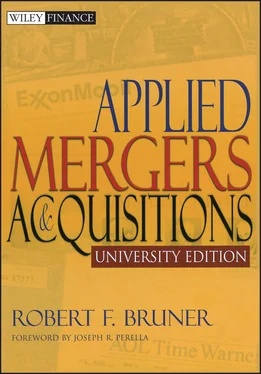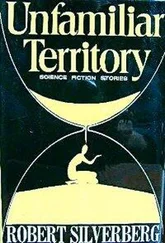Robert F. Bruner - Applied Mergers and Acquisitions
Здесь есть возможность читать онлайн «Robert F. Bruner - Applied Mergers and Acquisitions» — ознакомительный отрывок электронной книги совершенно бесплатно, а после прочтения отрывка купить полную версию. В некоторых случаях можно слушать аудио, скачать через торрент в формате fb2 и присутствует краткое содержание. Жанр: unrecognised, на английском языке. Описание произведения, (предисловие) а так же отзывы посетителей доступны на портале библиотеки ЛибКат.
- Название:Applied Mergers and Acquisitions
- Автор:
- Жанр:
- Год:неизвестен
- ISBN:нет данных
- Рейтинг книги:5 / 5. Голосов: 1
-
Избранное:Добавить в избранное
- Отзывы:
-
Ваша оценка:
- 100
- 1
- 2
- 3
- 4
- 5
Applied Mergers and Acquisitions: краткое содержание, описание и аннотация
Предлагаем к чтению аннотацию, описание, краткое содержание или предисловие (зависит от того, что написал сам автор книги «Applied Mergers and Acquisitions»). Если вы не нашли необходимую информацию о книге — напишите в комментариях, мы постараемся отыскать её.
Applied Mergers and Acquisitions — читать онлайн ознакомительный отрывок
Ниже представлен текст книги, разбитый по страницам. Система сохранения места последней прочитанной страницы, позволяет с удобством читать онлайн бесплатно книгу «Applied Mergers and Acquisitions», без необходимости каждый раз заново искать на чём Вы остановились. Поставьте закладку, и сможете в любой момент перейти на страницу, на которой закончили чтение.
Интервал:
Закладка:
A final comment: Statistical significance is not the same as economic materiality. To say that M&A transactions create or destroy value on average, one needs not only the proof of significance (i.e., that the result is not due to chance) but also materiality , that the wealth effect is something that shareholders or society should worry about. Many of the significant abnormal returns reported in event studies are as low as 1 or 2 percent—one might ask whether this is enough to care about. The answer is emphatically “yes.” Usually these returns occur over a few days. Abnormal returns of this magnitude in a short period of time are enough to cause concern or elation among institutions or other sophisticated investors whose performance in turn can be greatly affected by these kinds of events. One also needs to compare apples to apples: the M&A event returns must be annualized to compare them to other rates of return that investors experience. For instance, a 1 percent abnormal positive return to announcements by buyers that occurs over a week should be annualized by compounding one percent across 52 weeks to yield a 68 percent annualized gain. 6 This is merely theoretical: Reinvestment risk will frustrate attempts to invest in a way that reliably yields a 68 percent abnormal return each year. But in order to make fair comparisons of the materiality of M&A activity with other investing activity by corporations and institutions, it is necessary to adjust for differences in time frame.
EXHIBIT 3.2 Comparison of Research Approaches Regarding the Profitability of M&A
| Strengths | Weaknesses | |
|---|---|---|
| Market-based returns to shareholders (event studies) | A direct measure of value created for investors.A forward-looking measure of value creation. In theory stock prices are the present value of expected future cash flows. | Requires significant assumptions about the functioning of stock markets: efficiency, rationality, and absence of restrictions on arbitrage. Research suggests that for most stocks these are not unreasonable assumptions, on average and over time.Vulnerable to confounding events, which could skew the returns for specific companies at specific events. Care by the researcher and law of large numbers deal with this. |
| Accounting studies: returns estimated from reported financial statements | Credibility. Statements have been certified. Accounts have been audited.Used by investors in judging corporate performance. An indirect measure of economic value creation. | Possibly noncomparable data for different years. Companies may change their reporting practices. Reporting principles and regulations change over time.Backward-looking.Ignores value of intangible assets.Sensitive to inflation and deflation because of historic cost approach.Possibly inadequate disclosure by companies. Great latitude in reporting financial results.Differences among companies in accounting policies adds noise.Differences in accounting principles from one country to the next make cross-border comparison difficult. |
| Surveys of managers | Yields insights into value creation that may not be known in the stock market.Benefits from the intimate familiarity with the actual success of the acquisition. | Gives the perspectives of managers who may or may not be shareholders, and whose estimates of value creation may or may not be focused on economic value.Recall of historical results can be hazy, or worse, slanted to present results in the best light.Typically surveys have a low rate of participation (2–10%) that makes them vulnerable to criticisms of generalizability. |
| Clinical research (case studies) | Objectivity and depth in reconstructing an actual experience.Inductive research. Ideal for discovering new patterns and behaviors. | Ill-suited to hypothesis testing because the small number of observations limits the researcher’s ability to generalize from the case(s).The research reports can be idiosyncratic making it difficult for the reader to abstract larger implications from one or several reports. |
Source: Author’s analysis.
FINDINGS BASED ON THE ANALYSIS OF MARKET-BASED RETURNS TO SHAREHOLDERS
Event studies yield insights about market-based returns to target firm shareholders, buyers, and a combination of both.
Returns to Target Firms
Target firm shareholders enjoy returns that are significantly and materially positive. Exhibit 3.3summarizes the findings of 25 studies, which reveal returns that are material and significant, despite variations in time period, type of deal (merger vs. tender offer), and observation period. In short, the M&A transaction delivers a premium return to target firm shareholders.
Returns to Buyer Firms
The pattern of findings about market-based returns to buyer firms’ shareholders is more problematical.
There are 22 studies that report negative returns with 14 of the 22 significantly negative (see Exhibit 3.4). The significantly negative returns vary between 1 and 4 percent.
There are 32 studies (see Exhibit 3.5) that report positive returns—23 of these report significantly positive returns.
The studies of returns to buyer firm shareholders around the time of announcement are distributed with a slight positive bias: 26 percent (14) show value destruction (significantly negative returns); 31 percent (17) show value conservation (insignificantly different from zero): and 43 percent (23) show value creation (positively significant returns). EXHIBIT 3.3 Summary of Shareholder Return Studies for M&A: Returns to the Target Firm ShareholdersStudyCumulative Abnormal Returns (% or avg$/acq)Sample SizeSample PeriodEvent Window (Days)% Positive ReturnsNotesLangetieg (1978)+10.63% *1491929–1969(–120,0)71.6%Mergers; uses effective date as event date.Bradley, Desai, Kim (1988)+31.77% *2361963–1984(–5,5)95%Tender offers only; subperiod data available for 7/63–6/68, 7/68–12/80, 1/81–12/84; acquirer returns have increased from +19% to +35% over time.Dennis, McConnell (1986)+8.56% *761962–1980(–1,0)70%Jarrell, Poulsen (1989)+28.99% *5261963–1986(–20,10)N/ATender offers only.Lang, Stulz, Walkling (1989)+40.3% *871968–1986(–5,5)N/ATender offers only.Franks, Harris, Titman (1991)+28.04% *3991975–1984(–5,5)N/AMergers and tenders offers; segment data available on means of payment and competition.Servaes (1991)+23.64% *7041972–1987(–1,close)N/AMergers and tender offers; segment data by payment method.Bannerjee, Owers (1992)+$137.1 MM *331978–1987(–1,0)85%White knight bids.Healy, Palepu, Ruback (1992)+45.6% *501979–1984(–5,5)N/ALargest U.S. mergers during period.Kaplan, Weisbach (1992)+26.9% *2091971–1982(–5,5)94.7%Mergers and tender offers.Berkovitch, Narayanan (1993)+$130.1 MM *3301963–1988(–5,5)95.8%Tender offers.Smith, Kim (1994)+30.19% *+15.84% *1771980–1986(–5,5) (–1,0)96.0% 91.3%Successful and unsuccessful tender offers.Schwert (1996)+26.3% *6661975–1991(–42,126)N/AMergers, tenders offers; segment data available for various transaction attributes.Loughran, Vijh (1997)+29.6% *merger +126.9% *tender +47.9 *combined419 1351970–1989(–2,1,250)N/AFive-year postacquisition returns; segment data also available on form of payment.Maquieira, Megginson and Nail (1998)+41.65% *conglomerate +38.08% *nonconglomerate47 551963–1996(–60,60)61.8% 83.0%Study of returns for conglomerate and nonconglomerate stock-for-stock mergers.Eckbo, Thorburn (2000)+7.45% *3321964–1983–40,0)N/ACanadian targets only.Leeth, Borg (2000)+13.27% *721919–1930–40,0)N/AMulherin, Boone (2000)+21.2% *3761990–1999(–1,+1)N/AMulherin (2000) DeLong (2001)+10.14% *+16.61% *202 2801962–1997 1988–1995(–1,0) (–10,1)76% 88.6%A sample of incomplete acquisitions. Studied deals where at least one party is a bank.Houston et al. (2001)+15.58% *(1985–90) +24.60% *(1991–96) +20.80% *(all)27 37 641985–1996(–4,1)N/ADeals in which both parties are banks.Beitel et al. (2002)+10.48% *981985–2000(–1,0)53%Sample of European bank mergers.Kuipers, Miller, Patel (2003)+23.07% *1811982–1991(–1,0)N/AU.S. targets of foreign acquirers.Renneboog, Goergen (2003)+9.01% *1361993–2000(–1,0)N/AEuropean transactions.Billett, King, Mauer (2003)+22.15% *2651979–1997(–1,0 month)N/AUnless otherwise noted, event date is announcement date of merger/bid. *Significant at the 0.95 confidence level or better. EXHIBIT 3.4 Studies Reporting Negative Returns to AcquirersStudyCumulative Abnormal ReturnsSample SizeSample PeriodEvent Window (Days)% Positive ReturnsNotesLangetieg (1978)–1.61%1491929–1969(–120,0)47.6%Mergers; uses effective date as event date.Dodd (1980)–1.09% *601970–1977(–1,0)N/AMergers only. Daily data.successful–1.24% *unsuccessful66Asquith, Bruner, Mullins (1987)–0.85% *3431973–1983(–1,0)41%Varaiya, Ferris (1987)–2.15% *–3.9% *96 961974–1983 1974–1983(–1,0) (–20,80)N/A 42%Morck, Shleifer, Vishny (1990)–0.70%3261975–1987(–1,1)41.4%Measured return by comparing change in bidder market value to market value of target’s equity.Franks, Harris, Titman (1991)–1.45%3991975–1984(–5,5)N/AMergers and tenders offers; segment data available on means of payment and competition.Servaes (1991)–1.07% *3841972–1987(–1,close)N/AMergers and tender offers; segment data by payment method.Jennings, Mazzeo (1991)–0.8% *3521979–1985(–1,0)37%Bannerjee, Owers (1992)–3.3% *571978–1987(–1,0)21%White knight bids.Byrd, Hickman (1992)–1.2% * *1281980–1987(–1,0)33%Healy, Palepu, Ruback (1992)–2.2%501979–1984(–5,5)N/A50 largest U.S. mergers during period.Kaplan, Weisbach (1992)–1.49% *2711971–1982(–5,5)38%Mergers and tender offers.Berkovitch, Narayanan (1993)–$10 MM3301963–1988(–5,5)49.4%Tender offers.Sirower (1994)–2.3% *1681979–1990(–1,1)35%Eckbo, Thorburn (2000)–0.30%3901964–1983(–40,0)N/AU.S. acquirers of Canadian targets.Mulherin, Boone (2000)–0.37%2811990–1999(–1,+1)N/AMitchell, Stafford (2000)–0.14% * †–0.07%366 3661961–1993(–1,0)N/AFama and French three–factor model, applied to monthly returns.Walker (2000)–0.84% * ‡–0.77%278 2781980–1996(–2,+2)41.4% 46.4%DeLong (2001)–1.68% *280(1988–1995)(–10,1)33.6%Deals in which at least one party is a bank.Houston et al. (2001)–4.64% *(1985–1990)27(1985–1996)(–4,1)N/ADeals in which both parties are banks.–2.61% (1991–1996)37–3.47% *(all)64Ghosh (2002)–0.96%1,190(1985–1999)(–5,0)N/AKuipers, Miller, Patel (2003)–0.92% *138(1982–1991)(–1,0)N/AForeign acquirers of U.S. targets.Unless otherwise noted, event date is announcement date of merger/bid. *Significant at the 0.95 confidence level or better. †Top return is based on an equal-weighted benchmark portfolio. Bottom return is based on a value-weighted benchmark portfolio. ‡Top return is a return adjusted for market average returns. Bottom return is adjusted for return on a matched firm. EXHIBIT 3.5 Studies Reporting Positive Returns to AcquirersStudyCumulative Abnormal ReturnsSample SizeSample PeriodEvent Window (Days)% Positive ReturnsNotesDodd, Ruback (1977)+2.83% *successful1241958–1978(0,0)N/ATender offers only. Monthly data.+0.58% unsuccessful48Kummer, Hoffmeister (1978)+5.20% *successful171956–1970(0,0)N/ATender offers only. Monthly data.Bradley (1980)+4.36% *successful881962–1977(–20,+20)N/ATender offers only. Daily data.–2.96% unsuccessful46Jarrell, Bradley (1980)+6.66% *881962–1977(–40,+20)N/ATender offers only. Daily data.Bradley, Desai, Kim (1982)+2.35 *successful1611962–1980(–10,+10)N/ATender offers only. Daily data.Asquith (1983)+0.20% successful1961962–1976(–1,0)N/AMergers only. Daily data.+0.50% unsuccessful89Asquith, Bruner, Mullins (1983)+3.48% *successful1701963–1979(–20,+1)N/AMergers only. Daily data.+0.70% unsuccessful41Eckbo (1983)+0.07% successful1021963–1978(–1,0)N/AMergers only. Daily data.+1.20% *unsuccessful57Malatesta (1983)+0.90% successful2561969–1974(0,0)N/AMergers only. Monthly data.Wier (1983)+3.99% unsuccessful161962–1979(–10, cancellation date)N/AUnsuccessful mergers only. Daily data.Dennis, McConnell (1986)–0.12% (–1,0)901962–1980(–1,0)52%+3.24% (–6,+6) *Jarrell, Brickley, Netter (1987)+1.14% *4401962–1985(–10,5)N/ATender offers only; subperiod data available for 1962–69, 70–79, 80–85; acquirer returns have decreased from +4% to –l%Sicherman, Pettway (1987)+4.026% *related +0.047% unrelated49 981983–1985(–10,+10)N/ACompared returns to buyers of divested assets in related and unrelated industries.Bradley, Desai, Kim (1988)+ 1% *2361963–1984(–5,5)47%Tender offers only; subperiod data available for 7/63–6/68, 7/68–12/80, 1/81–12/84; acquirer returns have decreased from +4% to –3% over time.Jarrell, Poulsen (1989)+0.92% *4611963–1986(–5,5)N/ATender offers only.Lang, Stulz, Walkling (1989)0%871968–1986(–5,5)N/ATender offers only.Loderer, Martin (1990)+1.72% *1966–1968 +0.57% *1968–1980970 3,4011966–1984(–5,0)N/AMergers and tenders offers; segment data available on size of acquisition.–0.07% 1981–1984801Smith, Kim (1994)+0.50% –0.23%1771980–1986(–5,5) (–1,0)49.2% 76.2%Successful and unsuccessful tender offers.Schwert (1996)+1.4%6661975–1991(–42,126)N/AMergers, tenders offers; segment data available for various transaction attributes.Maquieira et al. (1998)+6.14% *nonconglomerate deals551963–1996(–60,60)61.8% 36.2%Study of returns in conglomerate and nonconglomerate stock-for-stock deals.–4.79% conglomerate47Lyroudi, Lazardis, Subeniotis (1999)0%501989–1991(–5,5)N/AInternational acquisitions by European and Japanese firms.Eckbo, Thorburn (2000)+1.71% *1,2611964–1983(–40,0)N/ACanadian acquirers of Canadian targets.Leeth, Borg (2000)+3.12% *4661919–1930(–40,0)N/AKohers, Kohers (2000)1.37% *cash deals 1.09% *stock961 6731987–1996(0,1)N/ASample of mergers among high-tech firms.1.26% whole sample1,634Mulherin (2000)+0.85% *1611962–1997(–1,0)49%Sample of incomplete acquisitions.Floreani, Rigamonti (2001)+2.63% *561996–2000(–5,+5)N/ASample of European insurance company mergers.Kohers, Kohers (2001)+0.92% *3041984–1995(–1,0)N/ASample of technology mergers.Beitel et al. (2002)+0.06%981985–2000(–1,0)53%Sample of European bank mergers.Fuller, Netter, Stegemoller (2002)+1.77% *all +2.74% *1st time bidders3,1351990–2000(–2, +2)N/ABillett, King, Mauer (2003)+0.15%8311979–1997(–1,0 month)N/AMoeller, Schlingemann, Stulz (2003)+ 1.13% *all +1.496% *private –1.020% *public12,0231980–2001(0,36 months)N/ATested the difference in bidder’s returns at acquiring private company, public company, or subsidiary of public company.+2.003% *subsidiaryRenneboog, Goergen (2003)+0.70% *1421993–2000(–1,0)N/AEuropean transactions.Unless otherwise noted, event date is announcement date of merger/bid. *Significant at the 0.95 confidence level or better.
Читать дальшеИнтервал:
Закладка:
Похожие книги на «Applied Mergers and Acquisitions»
Представляем Вашему вниманию похожие книги на «Applied Mergers and Acquisitions» списком для выбора. Мы отобрали схожую по названию и смыслу литературу в надежде предоставить читателям больше вариантов отыскать новые, интересные, ещё непрочитанные произведения.
Обсуждение, отзывы о книге «Applied Mergers and Acquisitions» и просто собственные мнения читателей. Оставьте ваши комментарии, напишите, что Вы думаете о произведении, его смысле или главных героях. Укажите что конкретно понравилось, а что нет, и почему Вы так считаете.












